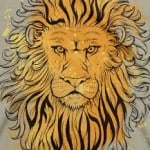Rabbi Chanan Morisson
Based on the teachings of Maran Harav Kook
Together with Shema
In the parashah of Balak, we find prophetic verses of exquisite beauty and an inspiring story of God’s vigilant watch over the Jewish people. But to truly appreciate this Torah portion, consider this remarkable teaching of the Sages.
The Talmud (Berachot 12b) relates that at one time the rabbis contemplated incorporating the parashah of Balak into the daily prayers, alongside the recitation of the Shema. This is truly astounding. What lesson is contained in the words of Balaam – a villainous prophet, steeped in blind hatred for the Jewish people — that could possibly compare to the Torah’s most fundamental beliefs, as delineated in the Shema, the centerpiece of Jewish prayer?
Fortunately, the Talmud clues us in to what makes this parashah so special. Its unique message may be found in the following verse, comparing the Jewish people to a fearsome lion:
“[Israel] crouches; he lies like a lion and a lioness. Who dares rouse him?” (Num. 24:9)
Yes, it is a beautiful metaphor describing the timeless strength and vitality of the Jewish people. But does this verse justify reading the entire portion of Balak twice a day, together with the Shema?
The Missing Link
Clearly, the Sages saw an inner link between Balak and the Shema. In order to understand this connection, we must first analyze the principal themes of the Shema. The Sages taught (Berachot 13a) that the first passage of the Shema expresses God’s unity and our acceptance of His rule; and that the theme of the second passage is our acceptance of the mitzvot.
However, these two axioms of Judaism — accepting God’s reign and accepting His mitzvot — are missing a common link. What is it that combines them, leading to universal acceptance of God through the performance of mitzvot? The missing link is the Jewish people.
The lofty aspirations expressed in the Shema necessitate the existence of a nation who, throughout the generations, observes the mitzvot and introduces the concept of God’s unity to the world. This is the mission of the Jewish people. In fact, they were created specifically for this purpose: “This people I created for Me, [so that] they will proclaim My praise” (Isaiah 43:21).
Now we can understand why the Sages wanted to add this particular verse to the recital of the Shema. Balaam poetically compared the Jewish people to a sleeping lion that none dare disturb. Everyone fears the formidable powers of this majestic creature, even when it sleeps. The latent power of the Jewish people is such that, even when ’sleeping’ — even when they are exiled from their land and many of their unique national institutions (the Temple, Sanhedrin, kohanim, prophets, etc.) are dormant — nonetheless, their eternal nature is legendary. [1]
The survival of the Jewish people throughout the generations, despite all odds, and in violation of all laws of history, enables them to persist in their mission of proclaiming God’s unity. Their indestructible nature is in itself a sanctification of God’s Name.
Jewish Nationalism
If the significance of the parashah of Balak can be reduced to this single verse, then why not just add that verse to the daily prayers? Why add the entire section?
The Talmud explains that we may not add the verse by itself, since the Torah should not be broken up arbitrarily. “Any section that Moses did not divide, we may not divide.”
This explanation is difficult to understand. We find many individual verses incorporated in the liturgy. Why not this one?
It appears that detaching this particular verse from the rest of Balaam’s prophecy poses a special danger. By itself, the verse could be construed as extolling nationalism for its own sake. The unique strength of the Jewish people is not meant to serve the goals of self-centered nationalism, military conquest, or national aggrandizement. The eternal nature of Israel must be understood within the context of their unique mission: to promulgate God’s Name in the world. Therefore we must take care not to separate this verse from the rest of the portion.
Appreciating the Message of Balak
In the end, the Sages did not add the parashah of Balak to the daily prayers. They felt that such a lengthy addition would be too great a burden for the people.
Reading this portion would be a burden, since its message is not applicable to every generation. Not every generation is able to appreciate the role that Israel’s timeless vitality plays in achieving its spiritual goals. Yet the very fact that the Sages wanted to incorporate it in the prayers indicates that a time will come when this message will be accepted and internalized by the nation as a whole.

(Sapphire from the Land of Israel. Adapted from Ein Eyah vol. I, pp. 67-68)
________________________________________
[1] Mark Twain wrote in 1898:
“[The Jew] has made a marvelous fight in the world, in all the ages; and has done it with his hands tied behind him. He could be vain of himself, and be excused for it. The Egyptian, the Babylonian, and the Persian rose, filled the planet with sound and splendor, then faded to dream-stuff and passed away; the Greek and the Roman followed, and made a vast noise, and they are gone; other peoples have sprung up and held their torch high for a time, but it burned out, and they sit in twilight now, or have vanished.
The Jew saw them all, beat them all, and is now what he always was, exhibiting no decadence, no infirmities of age, no weakening of his parts, no slowing of his energies, no dulling of his alert and aggressive mind. All things are mortal but the Jew; all other forces pass, but he remains. What is the secret of his immortality?” (Concerning The Jews, Harper’s Magazine, March 1898).
